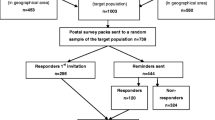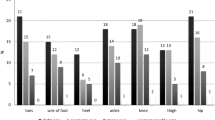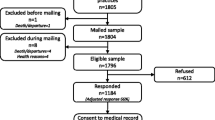Abstract
This study was conducted to determine the predictors of foot ulceration occurring in patients with rheumatoid arthritis (RA) without diabetes. A multi-centre case control study was undertaken; participants were recruited from eight sites (UK). Cases were adults diagnosed with RA (without diabetes) and the presence of a validated foot ulcer, defined as a full thickness skin defect occurring in isolation on / below the midline of the malleoli and requiring > 14 days to heal. Controls met the same criteria but were ulcer naive. Clinical examination included loss of sensation (10g monofilament); ankle-brachial pressure index (ABPI); forefoot deformity (Platto); plantar pressures (PressureStat); RA disease activity (36 swollen/tender joint counts) and the presence of vasculitis. History taking included past ulceration/foot surgery; current medication and smoking status. Participants completed the Health Assessment Questionnaire (HAQ) and Foot Impact Scale. A total of 83 cases with 112 current ulcers and 190 ulcer naïve controls participated. Cases were significantly older (mean age 71 years; 95 % confidence interval [CI], 69–73 vs. 62 years, 60–64) and had longer RA disease duration (mean 22 years; 19–25 vs. 15, 13–17). Univariate analysis showed that risk of ulceration increases with loss of sensation; abnormality of ABPI and foot deformity. Plantar pressures and joint counts were not significant predictors. HAQ score and history of foot surgery were strongly associated with ulceration (odds ratio [OR] = 1.704, 95 % CI 1.274–2.280 and OR = 2.256, 95 % CI 1.294–3.932). Three cases and two controls presented with suspected cutaneous vasculitis. In logistic regression modelling, ABPI (OR = 0.04; 95 % CI, 0.01–0.28) forefoot deformity (OR = 1.14; 95 % CI, 1.08–1.21) and loss of sensation (OR = 1.22; 95 % CI, 1.10–1.36) predicted risk of ulceration. In patients with RA, ABPI, forefoot deformity and loss of sensation predict risk of ulceration but, in contrast with diabetes, raised plantar pressures do not predict risk.

Similar content being viewed by others
References
Firth J, Hale C, Helliwell PS, Hill J, Nelson EA (2008) The prevalence of foot ulceration in patients with rheumatoid arthritis. Arthritis Care Res 59(2):200–205
Matricali GA, Boonen A, Verduyckt J, Taelman V, Verschueren P, Sileghem A, Corluy L, Westhovens R (2006) The presence of forefoot problems and the role of surgery in patients with rheumatoid arthritis. Ann Rheum Dis 65(9):1254–1255
Firth J, Nelson EA, Briggs M, Gorecki CA (2011) Qualitative study to explore the impact of foot ulceration on health-related quality of life in patients with rheumatoid arthritis. Int J Nurs Stud 48(11):1401–1408
Redmond AC, Waxman R, Helliwell PS (2006) Provision of foot health services in rheumatology in the UK. Rheumatology (Oxford) 45(5):571–576
Firth J, Nelson EA, Briggs M, Gorecki C (2013) Experiences of healthcare provision for foot ulceration occurring in people with rheumatoid arthritis. Musculoskelet Care. 11930:159-67. doi:10.1002/msc.1036
Dixon WG, Watson K, Lunt M, Hyrich KL, Silman AJ, Symmons DPM (2006) Rates of serious infection, including site-specific and bacterial intracellular infection, in rheumatoid arthritis patients receiving anti-tumor necrosis factor therapy — results from the British Society for Rheumatology Biologics Register. Arthritis Rheum 54(8):2368–2376
Singh N, Armstrong DG, Lipsky BA (2005) Preventing foot ulcers in patients with diabetes. JAMA 293(2):217–228
Jeffcoate WJ, Harding KG (2003) Diabetic foot ulcers. Lancet 361(9368):1545–1551
Anstead GM (1998) Steroids, retinoids, and wound healing. Adv Wound Care 11:277–285
Firth J, Hale CA, Hill J, Helliwell PS, Nelson EA (2008) The predictors of foot ulceration in patients with rheumatoid arthritis: a preliminary investigation. Clin Rheumatol 27(11):1423–1428
Stata. StataCorp (2009) Stata statistical software: release 11. StataCorp LP, College Station
Bakker K, Apelqvist J, Schaper, NC (2012) On behalf of the International Working Group. Practical guidelines on the prevention and management of the diabetic foot 2011. Diabetes / metabolism research and reviews 28(1): 225–231
Vowden KR, Vowden P (2001) Doppler assessment and ABPI : interpretation in the management of leg ulceration. http://www.worldwidewounds.com/2001/march/Vowden/Doppler-assessment-and-ABPI.html. Accessed 03/10/13
Platto MJ, O'Connell PG, Hicks JE, Gerber LH (1991) The Relationship of pain and deformity of the rheumatoid foot to gait and an index of functional ambulation. J Rheumatol 18:1
Garrow AP, Papageorgiou A, Silman AJ, Thomas E, Jayson MIV, Macfarlane GJ (2001) The grading of hallux valgus: the Manchester scale. J Am Podiatr Med Assoc 91(2):74–78
Bailey Instruments Ltd: Manchester, UK http://www.baileyinstruments.co.uk/
Firth J, Turner, Smith DE, Woodburn J, Helliwell PS (2007) The validity and reliability of PressureStat™ for measuring plantar foot pressures in patients with rheumatoid arthritis. Clin Biomech 22(5):603–606
Helliwell PS, Reay N, Gilworth G, Redmond A, Slade A, Tennant A, Woodburn J (2005) Development of a foot impact scale for rheumatoid arthritis. Arthritis Rheum 53(3):418–422
Kirwan JR, Reeback JS (1986) Stanford Health Assessment Questionnaire modified to assess disability in British patients with rheumatoid arthritis. Br J Rheumatol 25:206–209
Shrier I, Platt RW (2008) Reducing bias through directed acyclic graphs. BMC Med Res Methodol 8:70. doi:10.1186/1471-2288-8-70
IBM SPSS (2003) SPSS data entry: version 4. Chicago, IL, USA
Lanzanillo B, Pappone N, Crisci C, di Girolamo C, Massini R, Caruso G (1998) Subclinical peripheral nerve involvement in patients with rheumatoid arthritis. Arthritis Rheum 41(7):1196–1202
Agarwal VV, Singh RR, Wiclaf, Chauhan SS, Tahlan AA, Ahuja CK et al (2008) A clinical, electrophysiological, and pathological study of neuropathy in rheumatoid arthritis. Clin Rheumatol 27(7):841–844
Wilson O, Kirwan JR (2006) Measuring sensation in the feet of patients with rheumatoid arthritis. Musculoskelet Care 4(1):12–23
Otter SJ, Lucas K, Springett K, Moore A, Davies K, Young A, Walker-Bone K (2011) Comparison of foot pain and foot care among rheumatoid arthritis patients taking and not taking anti-TNFα therapy: an epidemiological study. Rheumatol Int 31(11):1515–1519
Lavery LA, Armstrong DG, Vela SA, Quebedeaux TL, Fleischli JG (1998) Practical criteria for screening patients at high risk for diabetic foot ulceration. Arch Intern Med 158(2):157–162
Tuna H, Birtane M, Tastekin N, Kokino S (2005) Pedobarography and its relation to radiologic erosion scores in rheumatoid arthritis. Rheumatol Int 26:42–47
Van der Leeden M, Steultjens M, Dekker JHM, Prins APA, Dekker J (2006) Forefoot joint damage, pain and disability in rheumatoid arthritis patients with foot complaints: the role of plantar pressure and gait characteristics. Rheumatology 45(4):465–469
Anderson RB, Hodge Davis W (1997) The pedorthic and orthotic care of the diabetic foot. Foot Ankle Clin 2(1):137–151
Edmonds ME, Blundell MP, Morris ME, Thomas EM, Cotton LT, Watkins PJ (1986) Improved survival of the diabetic foot: the role of a specialised foot clinic. Q J Med 60(232):763–771
Shanmugam KV, DeMaria DM, Attinger CE (2011) Lower extremity ulcers in rheumatoid arthritis: features and response to immunosuppression. Clin Rheumatol 30(6):849–853
Murray HJ, Young MJ, Hollis S, Boulton AJ (1996) The association between callus formation, high pressures and neuropathy in diabetic foot ulceration. Diabet Med 13(11):979–982
Veves A, Murray HJ, Young MJ, Boulton AJM (1992) The risk of foot ulceration in diabetic patients with high foot pressure: a prospective study. Diabetologia 35:660–663
Woodburn J, Helliwell PS (1996) Relationship between heel position and the distribution of forefoot plantar pressures and skin callosities in rheumatoid arthritis. Ann Rheum Dis 55(11):806–810
Lavery LA, Peters EJG, Armstrong DG (2008) What are the most effective interventions in preventing diabetic foot ulcers? Int Wound J 5:425–433
Podiatric Rheumatic Care Association (2008) Standards of care for people with musculoskeletal foot health problems. Arthritis and Musculoskelet Alliance. www.prcassoc.org.uk/standards-project
Disclosure
None.
Author information
Authors and Affiliations
Corresponding author
Additional information
Significance and Innovations
• ABPI, forefoot deformity and loss of sensation predict risk of foot ulceration in patients with RA
• In contrast with diabetes, raised plantar pressures did not predict risk of ulceration in this study
This work was funded by the award of the Ann Wilks Grant by the Arthritis Research Trust (Yorkshire).
Rights and permissions
About this article
Cite this article
Firth, J., Waxman, R., Law, G. et al. The predictors of foot ulceration in patients with rheumatoid arthritis. Clin Rheumatol 33, 615–621 (2014). https://doi.org/10.1007/s10067-013-2428-7
Received:
Revised:
Accepted:
Published:
Issue Date:
DOI: https://doi.org/10.1007/s10067-013-2428-7




